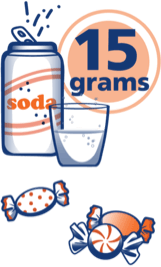
MOVING
A body in motion stays in motion

How to start and stick with your diabetes activity plan.
Deciding to move more is a great start. But the real key is to make your activity plan a regular part of your diabetes management. So, how do you stay on course? Here are a few tips:
Start right away…like today
The first step is to do a little more activity than you’re doing right now. Be creative. Start with simple choices that bring more physical activity into your day, like walking more—when going to and from work, getting lunch, shopping, or seeing neighbors and family.
Start small
A simple way to start might be with a 5-minute stroll. Join the neighborhood watch or another community organization to get out and meet people. Slowly, you can build up to 10-minute walks, then to 15-minute walks, and so on.
Bring a friend along
Ask a friend or family member to join you. Making plans with another person helps you stick to your plan.
Be careful with your feet
Diabetes can affect your feet, so be sure to take very good care of them. Check your feet every day, especially after being active. And tell your doctor if something doesn’t seem right.
Watch out for low blood glucose (hypoglycemia)
Check your blood glucoseBlood glucoseThe main sugar found in the blood, and the body’s main source of energy. before and after physical activity. Have a carbohydrateCarbohydrateCarbohydrates are the main kinds of food that raise blood glucose levels. Your digestive system changes carbohydrates into glucose, and then uses this glucose as a source of energy for your cells.
There are 3 main types of carbohydrates in food: starches (complex carbohydrates), sugars (simple carbohydrates), and fiber. Fiber is the part of plant foods, including fruits, vegetables, and nuts, that you can’t digest. (or carb) snack handy in case you need it.
If you think your blood glucose is low, eat 15 grams of carbs right away, such as:

- 4 ounces (1/2 cup) of regular fruit juice (like orange or apple juice) or 8 ounces (1 cup) of nonfat or 1% milk
- 4 ounces (1/2 cup) of regular soda pop (not diet)
- 4 glucose tablets
- Candies that you can chew quickly (for example, 7 gummies)
- 2 tablespoons of raisins
Make activity plans that are a good fit for you
You may not have been active in a while. But you can start now! Here are some suggestions to help:
- There’s no need to spend money on a health club. You can visit local parks, trails, a school gym, or a community center
- Start slowly and work your way up to at least 150 minutes or more of moderate-to-vigorous aerobic activity per week, spread over at least 3 days. Don't go more than 2 days without being active
- It’s never too late to begin to be active. Choosing a low-impact activity is one way to avoid aches, pains, and injuries
- Always talk to your doctor when you start or change any activity
Before you know it, you may see some changes like better sleep, more energy, and blood glucose levels that are closer to your goals. In time, you may start to lose weight and see other physical changes to your body, too.


